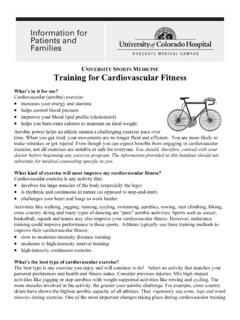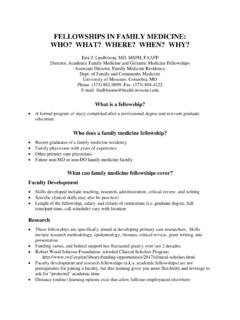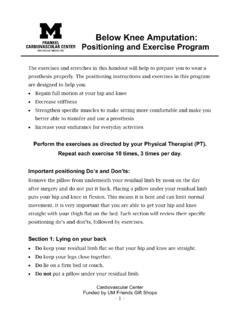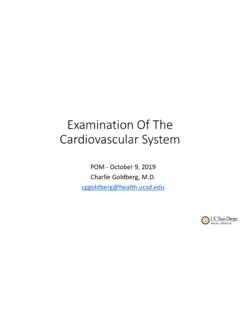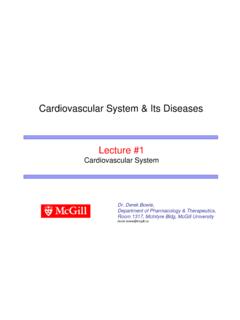Transcription of Ftplectures Cardiovascular system Lecture Notes CARDIOLOGY
1 Ftplectures Cardiovascular system Lecture Notes CARDIOLOGY medicine made simple This content is for the sole use of the intended recipient(s) and may contain information that is proprietary, confidential, and exempt from disclosure under applicable law. Any unauthorized review, use, disclosure, or distribution is prohibited. All content belongs to Ftplectures , LLC. Reproduction is strictly prohibited. COPYRIGHT RESERVED Ftplectures Cardiovascular system Copyright 2014 Adeleke Adesina, DO Cardiovascular system 2012 Ftplectures LLC 1133 Broadway Suite 706, New York, NY, 10010 The field of medicine is an ever-changing profession and as new evidence based studies are conducted, new knowledge is discovered. Ftplectures has made tremendous effort to deliver accurate information as per standard teaching of medical information at the time of this publication.
2 However, there are still possibilities of human error or changes in medical sciences contained herein. Therefore, Ftplectures is not responsible for any inaccuracies or omissions noted in this publication. Readers are encouraged to confirm the information contained herein with other sources. ALL RIGHTS RESERVED. This book contains material protected under International and Federal Copyright Laws and Treaties. Any unauthorized reprint or use of this material is prohibited. No part of this book may be reproduced or transmitted in any form or by any means, electronic or mechanical, including photocopying, recording, or by any information storage and retrieval system without express written permission from Ftplectures . Future teaching physicians Lectures LLC medicine made simple Title: Abdominal Aortic Aneurysm Objectives for learning: Define AAA, risk factors, causes, pathogensis, diagnosis and treatment.
3 Definition: Aneurysms are enlarged blood vessels. Aortic aneurysm are mostly infrarenal. Causes/ Risk factors: High incidence in males, Age > 50 years, (65- 70 years) - Smoking increases risk of developing AAA- due deposition of atherosclerosis deposition of fatty plaques inside the wall of the abdominal aorta. This causes the wall to weaken, and that weakening causes that to balloon out. Atherosclerosis pathogenesis is due to deposit LDL which the macrophages are getting caught, eat it up, and become forming macrophages. They are going to cause the proliferation of the smooth muscle cells, they are going to form a plaque which is going to form in the walls of this aorta.
4 And that plus smoking, hyperlipidemia, which means high LDL and low HDL, basically is going to predispose you to develop the aneurysm. - Hypertension, - Vasculitis inflammation of small blood vessels in aorta leading to ischemia and weakening of aortic walls. - Syphilis - Marfan syndrome - Fibrillin deficiency or any connective tissue disorder Pathophysiology Clinical symptoms and signs - patients are asymptomatic except when aorta ruptures - palpable, pulsating abdominal mass - ruptured AAA is a life threatening emergency with a mortality of 90%. The pumping heart pumps all the cardiac output into the abdominal cavity leading to sever hemorrhagic shock.
5 Symptoms - severe abdominal or lower back pain,- patient complain of sudden onset of abdominal pain. - Physical Exam may show grey tunre sign- flank ecchymosis - Cullens sign- Periumbilical ecchymosis- sign of blood in abdominal cavity Sigs: Triad of AAA- hypotension, abdominal pain, and pulsatile abdominal mass. Possible syncope if sever hypotension from hemorrhagic shock and inadequate perfusion to brain. - nausea, vomiting. Diagnosis Ultrasound- 100% sensitive CT scan only for stable patient with no hemodynamic instability- normal blood pressure Treatment Surgery with synthetic graft Treat risk factors- Hyperlipidemia with statins, hypertension with beta- blockers, thiazides, or ACE inhibitors Advice patient to stop smoking because it increases risk of developing another AAA Future teaching physicians Lectures LLC medicine made simple Title: Acute Coronary Syndrome Objectives for learning: Understanding the basic facts about acute coronary syndromes including unstable angina, NSTEMI and STEMI.
6 Definitions: Acute coronary syndrome encompasses unstable angina (USA), non- ST elevation (NSTEMI), and myocardial infarction (STEMI). Causes/ Risk factors: Stable angina Smoking Diabetes Obesity Pathophysiology: Atherosclerotic plaques in coronary arteries cause the initial pathology. The plaque can rupture which leads to increased tendency to increased thrombosis. Thrombosis can lower the blood flow through the affected coronary artery, thus causing ischemia to the regions distal from the occlusion. Unstable angina appears on the basis of previously developed stable angina. Due to seriously decreased diameter of coronary blood vessels caused by atherosclerotic plaque progression, these patients have increased frequency of chest pain occurring even during the rest.
7 Non- STEMI is the type of myocardial infarction which is not big enough to cause ST- elevation. Clinical symptoms and signs Increased frequency of chest pain even during the rest Prolonged duration of chest pain (>10 minutes) Diagnosis EKG can be normal in the case of unstable angina and NSTEMI, but it can also show ST- depression and T wave inversion due to the ischemia. ST- depression has to be greater than mm and T inversion greater than 2 mm in order to be significant. In order to distinguish unstable angina and NSTEMI, cardiac enzymes are used (CK- MB, Troponin I/T) Treatment Morphine Oxygen Nitrates Aspirin (COX- inhibitor which decreases tromboxan A2 and platelet aggregation) Beta- blockers (decreasing heart frequency and blood pressure) Glycoprotein IIb / IIIa inhibitors Exonoparin (low- molecular heparin) Coronary catheterization is performed if the patient is not feeling better after medicamentous treatment.
8 Lifestyle modifications: Diet Exercise Glucose control Statins Stop smoking Lose weight Future teaching physicians Lectures LLC medicine made simple Title: Acute Myocardial Infarction (MI) Objectives for learning: Learning the pathophysiological and clinical features of acute myocardial infarction, as well as treatment options. Definitions: Acute myocardial infarction is necrosis of myocardium due to massive ischemia caused by coronary artery occlusion. It is the most common cause of the death in the United States (30% mortality). Causes/ Risk factors: Acronym: FLASH MD Family history Low HDL Age (men>45, women>55) Smoking Hypertension Male gender Diabetes Pathophysiology: Acute myocardial infarction represents the necrosis of some parts of heart muscle which happens due to the massive ischemia caused by complete occlusion of the coronary artery responsible for supplying that region.
9 Clinical symptoms and signs Chest pain (crushing; radiation to the neck, jaw, and left arm) Nausea Vomiting Diaphoresis Shortness of breath Weakness, fatigue Symptoms last more than 30 minutes. Atypical clinical picture in: Diabetics Elderly Women St. post surgery Diagnosis EKG changes (ST- elevation, Q- waves (at least and 25% of R wave), T- waves inversion o I, aVL, V5, V6 lateral wall o V1, V2, V3 anterior wall o II, III, aVF inferior wall o V1, V2 Septal wall Cardiac enzyme o CK- MB (increases during the first 4- 8 hours; returns to normal values after 48- 72 hours) o Troponin I/T (increases in the first 3- 5 hours.))
10 Returns to normal values after 5- 14 days) * CK- MB is an important marker for reinfarction Complications Ventricular fibrillation Reinfarction Treatment Morphine Oxygen Nitrates Aspirin antiplatelet (aspirin decreases mortality) Beta- blockers (reduce mortality) ACE inhibitors Statins Anticoagulant - Low molecular weight heparine Revascularization Future teaching physicians Lectures LLC medicine made simple Title: Acute Pericarditis Objectives for learning: Learning clinical signs, diagnostic techniques, and treatment options for acute pericarditis. Definitions: Pericarditis is an inflammation of pericardium. Causes/ Risk factors: Idiopathic Viruses (Coxsackie B, HIV, Echoviruses) Radiation Uremia Acute myocardial infarction (Dressler s syndrome) Lupus Amyloidosis Rheumatoid arthritis Sarcoidosis Procainamide, hydralazine, izoniazide (drug induced pericarditis) Clinical symptoms and signs Retrosternal chest pain (pleuritic pain which radiates to trapezius or scapula) o Leaning forward lowers the pain.

